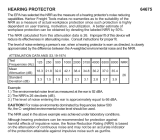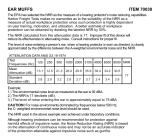
E•A•RLog® is a registered trademark of Aearo Company. Copyright 1996. First printing 1984
LIT. CODE 30297 2/99 AG
Although this procedure is not explicitly pre-
sented in the Amendment, it is scientifically
acceptable and has been implemented else-
where
8
.
The procedure is as follows:
1) Obtain an A-weighted noise dose.
2) Using a sound level meter
possessing C- and A-weighting,
develop a C-A value for typical
processes, areas, or job
descriptions.
3) Add the C-A value to the measured
A-weighted TWA to calculate the
estimated C-weighted TWA.
4) Subtract the NRR from the
estimated C-weighted TWA.
To the extent that an accurate C-A value
can be estimated, this procedure will pro-
vide enhanced accuracy over the Adjusted
NRR Method for those situations in which
C-weighted TWAs are unavailable.
EPA Labeling Requirements
A point of confusion exists between OSHA's
Appendix B and the information which, ac-
cording to EPA regulations
3
, must accom-
pany hearing protector packaging. The con-
fusion arose since EPA chose to accom-
modate those users whom it feared would
lack C-weighted measurement capabilities.
It did this by effectively developing a two-
number rating system, without ever explic-
itly stating that fact
9
.
The EPA method requires that the user sub-
tract the (unadjusted) NRR from an A-
weighted sound level to estimate the
wearer's protected exposure. A cautionary
note is included which states:
"For noise environments dominated by
frequencies below 500 Hz the
C-weighted environmental noise level
should be used." Thus, depending upon the
particular C-A value of the noise environ-
ment, which will increase in proportion to
the amount of lower frequency energy
present, the NRR is to be subtracted from
either an A- or a C- weighted sound level. In
practice, it matters little from which weighted
sound level the NRR is subtracted when C-
A values are near zero, but for noises with
significant low frequency energy and there-
fore higher C-A values, errors of 10 dB or
more can arise if the NRR is misapplied.
Unfortunately it is precisely those individu-
als for whom the EPA Method was intended
who are most likely to misuse the NRR.
Since they lack C-weighted instrumentation
they will be unaware when dominant energy
is present below 500 Hz, and thus will be
unable to judge from which weighted sound
level the NRR must be subtracted. In com-
parison to the NRR Method, or even the Ad-
justed NRR Method, the EPA's procedure
is less accurately defined, more easily mis-
applied, and less effective at estimating HPD
adequacy.
Real World Attenuation
OSHA does not require that an employer
estimate the actual attenuation that its work-
ers obtain from the devices as worn. This
actual or real world attenuation is known to
be significantly less than published labora-
tory data for a number of reasons
10
prima-
rily involving differences in training, motiva-
tion, and utilization, between users (the
noise-exposed work force) and testers
(laboratory subjects). The problem is well
recognized by experts in the field, and
deratings such as subtracting 10 dB from
published NRRs have been proposed
6
. But,
thus far there has been no consensus in
the professional or regulatory communities
on how to derate laboratory data, or how to
otherwise account for the discrepancies.
In the Hearing Conservation Amendment,
acknowledgement of disparities between
laboratory and real world data is limited to
a short note in Appendix B which states:
The employer must remember that
calculated attenuation values reflect
realistic values only to the extent that the
protectors are properly fitted and
worn.
This warning is crucial, since proper fitting
and wearing of HPDs by the industrial work
force is probably the single most difficult
element to execute in a hearing conserva-
tion program. It requires not only education,
training, and the selection of comfortable
and effective HPDs, but perhaps more im-
portantly, motivation, enforcement, and re-
sponsiveness to the needs of the hearing
protected employees. Guidance on these
issues may be found in EARLogs 3, 5, 7,
and 8- 10
1
.
References and Footnotes
1. Berger, E.H. - The EARLog Series is available upon
request from Aearo Company.
2. The Amendment does not specify a particular test
procedure for developing attenuation data. However,
for current manufacturers’ data to be in compliance
with the EPA labeling regulations
3
, tests will be in
conformance with ANSI S3.19-1974.
3. EPA (1979). "Noise Labeling Requirements for Hearing
Protectors," Fed. Regist. 42(190), 40CFR Part 211,
56139-56147.
4. NIOSH (1975). "List of Personal Hearing Protectors
and Attenuation Data," U.S. Dept. of HEW, Report No.
76-120, Cincinnati, OH.
5. Berger, E.H. (1980). "Suggestions for Calculating
Hearing Protector Performance," Sound Vibration
14(1), 6-7.
6. Berger, E.H. (1983). "Using the NRR to Estimate the
Real World Performance of Hearing Protectors,"
Sound and Vibration 17(1), 12-18.
7. Sutton, G.J. and Robinson, D.W. (1981). "An Appraisal
of Methods for Estimating Effectiveness of Hearing
Protectors," J. Sound Vib. 77(1), 79-81.
8. Dept. of Transportation (1982). "Navigation and Vessel
Inspection Circular No 12-82, Recommendation on
Control of Excess Noise," U.S. Coast Guard Report,
Wash., D.C.
9. When the EPA first published the labeling regulations
for public comment (1977, Federal Register, V42(120)
40CFR, Part 211, 31730-31738), they chose to
implement the NRR in the mathematically correct
manner, i.e. subtracting it from a dBC level. It was only
in the final and existing version of the regulation
3
, that
the procedure described in the text appeared.
10.Berger, E.H. (1980). "EARLog #5 - Hearing Protector
Performance: How They Work - And - What Goes
Wrong in the Real World," available upon request from
Aearo Company.





